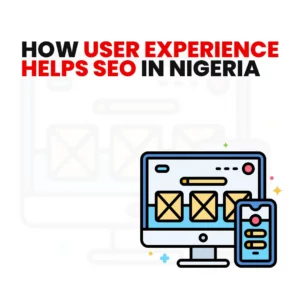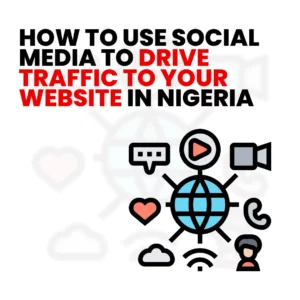Visuals are the captivating brushstrokes that colour your online experience. The first time you visit a website is like the beginning of a thrilling story, and images are the protagonist. “You never get a second chance to make a first impression” is more accurate than ever online. A website’s images welcome you with a warm handshake, establishing the tone for your visit. A beautiful design draws you in. The colours, imagery, and aesthetics make an instant connection, or failing to do so might be disastrous. This article explores the impact of visual storytelling in web design.
Why is visual storytelling in web design important?
Did you know visually appealing websites get more traffic? Based on research, content with relevant photos gets 94% more views than text alone. Visuals engage audiences, deliver information quickly, and generate emotions that match their experiences.
Imagine the last webpage that made you stop and take it all in. The emotional impact of pictures likely made the encounter memorable. Images that speak to your emotions, like a family portrait on a home design site or a business’s visual logo, create a connection.
Visuals’ power comes from their capacity to transcend aesthetics. They tell stories that provoke emotions, convey messages, and stick in your digital memory. Pay attention to the visuals you see online—they’re not just pixels on a screen; they’re the storytellers.
Read also: How to Create a Cohesive Brand Identity in Web Design

6 benefits of visual storytelling in web design
Visual storytelling in web design becomes a powerful companion as you traverse the internet. Instead of static pages with infinite text, you’re greeted by a visual tale that engages, moves, and immerses you. Let’s explore the many benefits of visual storytelling in web design.
- More engagement: Stunning visuals take centre stage in modern web design. Instead of lines of text, you get attractive visuals, bright graphics, and a stunning video background. This visual engagement is a digital handshake that invites further exploration. The difference between entering a dull environment and a visually engaging one that intrigues you.
- Effective communication: In the fast-paced digital world, time matters. Visual storytelling speeds up communication. Complex information is simplified in infographics. A glance conveys the message without deciphering long phrases. Visuals overcome verbal limitations to communicate ideas quickly and efficiently.
- Emotional resonance for deeper connection: Text conveys facts, while images evoke emotions. Imagine shopping on an e-commerce site where product visuals reflect lifestyle, desire, and features. Visual storytelling creates emotional connections beyond transactional ones. It’s the difference between an informative and a narrative website.
- Brand identity: Visual storytelling shapes brand identities in the digital context of brands and businesses. Consistent colours, fonts, and graphics reinforce brand personality. A consistent visual design throughout social media, websites, and email campaigns leaves a lasting impact.
- Improved retention: Have you visited a website and remembered its visuals days later? Visual narrative improves memory. Information is recalled better when given aesthetically. Images, colours, and tales make a website experience memorable.
- Enhanced user experience: Visual storytelling goes beyond aesthetics to provide a seamless user experience. Visually appealing websites are easy to use. Logical menu layouts and appropriately placed visual signals improve the user experience, making digital discovery easy and fun.
3 elements of visual storytelling
As you explore web design, you realize that visual narrative is magic. Imagine each aspect as a jigsaw piece that fits effortlessly to create a compelling mosaic that communicates your unique story.
1. Impressive images
Images—visual heroes—are first. Website aesthetics greet visitors initially. High-quality photos and graphics create an atmosphere, not just beauty. Each photo is a brushstroke that paints a vivid vision in your mind, whether it’s a product gallery or a vacation blog.
Visuals develop a language of their own as you explore the digital world, communicating directly to your emotions and preferences. Images convey tales, messages, and create an immersive experience that makes you a participant in the story.
2. Typography & fonts
Let’s discuss fonts—the unsung heroes. Website typography conveys tone, personality, and brand identification. Fonts for headlines, body text, and everything in between help tell the story.
Fonts help readers through a web page’s story. A trendy typeface may express innovation, whereas a classic serif font may convey trustworthiness. These small design choices impact your vision, making textual material essential to visual storytelling.
3. Colour psychology
Colours affect emotion and perception, not just the appearance of a webpage. Website colour palettes are carefully chosen to express stories.
Consider the influence of warm, inviting colours on a hospitality website or tranquil blues and greens on a wellness platform. These choices are chosen to evoke distinct feelings and behaviours. Colours lead your emotional journey across a site, producing a unified and memorable experience.
Visual narrative elements are storytellers, not just design decisions. They collaborate to create an immersive, personalized web experience with a narrative that speaks to you. As you click, scroll, and explore, pay attention to the visual elements—they create the digital story you see.
How to create a seamless visual journey in web design
As you navigate the internet, a flawless user journey becomes increasingly essential. Consider this a well-guided tour with deliberate clicks and scrolls. The user journey is a story designed to make your experience easy, intuitive, and pleasurable.
1. Guide users with straightforward navigation
Navigation guides you through a website’s virtual world from the start. Effective navigation affects how easily you find information, products, and services. Walking through a busy city without street signs would be confusing and irritating. A well-designed website makes every page a signpost, quickly guiding you to your target.
User-friendly navigation improves your experience and saves time. You feel in control as you smoothly transition between sections. Logical information flow and clear navigation make your journey purposeful and pleasurable.
2. Maintain consistent experience across devices
In this age of digital gadgets, your online journey goes beyond a PC. Responsive design makes the user journey consistent and engaging on laptops, tablets, and smartphones.
Imagine browsing a website’s beautiful images and engaging content on a PC. Later, switching to your smartphone on the road is easy. The responsive design maintains accessibility and aesthetics across screen sizes. Your journey adapts smoothly to your device, creating a seamless experience.
3. Explore user-centered design
Every decision in user-centric design centres on you—the digital adventurer. Layout, content, and interactivity are designed to improve your experience. User-centric design is understanding your wants and preferences to make every encounter feel right.
Imagine a website where every click is intentional rather than random. That defines a good user journey. It anticipates your wants, gives intuitive pathways, and makes you feel like an active participant in the story.
Tools and techniques for visual storytelling in web design
As you explore visual storytelling, you’ll find many tools and approaches to improve your digital narratives. Consider these instruments your artistic partners, each with a unique brushstroke, giving richness and vibrancy to your visual story. Let’s journey together and learn the fundamental skills and approaches to tell great visual stories.
1. Video and animation expertise
Videos and animations are our first choice. These silver screen moments of your digital narrative grab attention and deliver messages better than static visuals. These multimedia pieces are your storytellers in motion, whether a brand video’s immersive storytelling or entertaining animations accompanying interactive aspects.
Use video backgrounds to set the mood or subtle animations to highlight essential features. Multimedia changes your story from still frames to a cinematic experience that captivates your audience.
2. Participate in Interactive Storytelling
Could your audience actively participate in your visual narrative? Explore interactive storytelling. Interactive components, quizzes, and clickable hotspots let your audience co-create the story. Your visual tale becomes a two-way street when the passive observer becomes an involved explorer.
Imagine a product demonstration where you can spin and zoom in on a 3D model or a storytelling experience where your decisions affect the plot. These interactive technologies make your visual story a shared trip rather than a presentation.
3. Use authentic narratives in user-generated content
Your audience has a wealth of stories. Promote user-generated content as a visual storytelling tool. This might be user-submitted photographs, testimonials, or creative contributions that fit your brand narrative.
Visuals become more authentic and accessible when your audience participates in storytelling. Your audience becomes important characters in the story, making it a community storytelling experience.
4. Visual editing tools
Every spectacular visual story has trustworthy editing tools. These tools are your virtual brushes for picture editing, graphic design, and more. From Adobe Creative Suite to Canva, these services let you customize your images to meet your story.
Try different filters, colour palettes, and layouts until each visual aspect fits the story. Learning these skills lets you direct and ensure every frame fits the visual symphony you’re creating.
Read also: 11 Web Design Best Practices for SEO
6 Best practices of visual storytelling in web design
Learning visual storytelling in web design is like unlocking a world of digital creativity. Best practices will guide you to building engaging and immersive online experiences. So, fellow web builders, let’s explore these best practices—your trusty tools for creating captivating visual tales.
- Tailor stories to your Audience’s hearts and minds: Understand your audience before sketching the first line of your visual tale. Who are they? What moves them? Knowing your audience helps you create images that resonate with them. Understanding your audience is critical to visual storytelling, whether you’re creating for techies or art lovers.
- Maintain brand consistency: Keep your visuals consistent to make them memorable. Ensure all visual elements match your brand, from colours and fonts to imagery and design. Your brand stands out digitally with consistent branding and a clear visual narrative.
- Focus on visual hierarchy: Visual narrative follows a hierarchy. It guides the viewer’s gaze—position crucial elements to guide your story. Visual hierarchy organizes and simplifies your message, whether it’s a call-to-action button or an image’s main point.
- Use microinteractions to tell stories: Microinteractions in web design are small animations or responsive elements that respond to user inputs. Hovering over a button provides good feedback, and portions transition smoothly. Though little, these micro-interactions make your visuals an engaging journey.
- Implement a mobile-first approach: A mobile-first approach is innovative in a world with displays of all sizes. Make your visual narrative as effective on mobile as on desktop. Responsive design creates narratives that work across screen sizes, not just a keyword.
- Use white space purposefully: Negative or white space lets your visuals pop. Don’t overcrowd your canvas; let your images shine. Purposeful white space boosts aesthetics and directs attention. Consider it the pause between sentences—essential for clarity and emphasis.
Hire a web designer in Nigeria
Remember that every visual aspect is an opportunity to connect, engage, and leave a lasting impression as you create websites. Understanding your audience, branding consistently, and using visual hierarchy are the secrets to captivating digital tales. Contact me for a personalized consultation if you’re motivated to use visual storytelling to transform your digital presence. Let’s create a visual narrative that boosts your internet presence in Lagos, Abuja, or wherever in Nigeria.
Ready to explore visual storytelling? Book a session to create your digital narrative. Your story needs a digital masterpiece.




